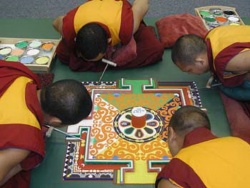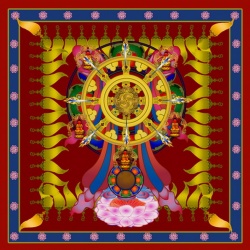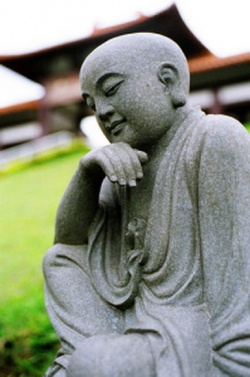Bhūridatta Jātaka
Bhūridatta Jātaka (No.543)
Prince Brahmadatta, son of the king of Benares, lived on the banks of the Yamunā, exiled from his father's kingdom. He wore the garb of an ascetic, but his heart was not in the ascetic life, and, when a Nāga maiden tried to seduce him, he easily succumbed. Their children were Sāgara Brahmadatta and Samuddajā. When the king of Benares died, Brahmadatta returned with his children to the kingdom and his Nāga wife returned to the Nāga world. While playing about in a lake specially prepared for them, the children of Brahmadatta discovered a tortoise, Cittacūla, and were much frightened. Cittacūla was brought before the king and was ordered to be cast into the Yamunā, that being the direst penalty the king could envisage. Caught in a whirlpool, Cittacūla was carried to the realm of the Nāgaking Dhatarattha, and, when questioned, had the presence of mind to say that he had been sent from Benares to propose a marriage between Dhatarattha and Samuddajā.
Nāga messengers were sent to the Benares court to make arrangements, and they laid their proposal before the king. Cittacūla had meanwhile spirited himself away. Brahmadatta was horrified at the proposals of the messengers, and did not fail to say so, whereupon Dhatarattha was so incensed at the insult offered to him that he laid siege to Benares with his Nāga hosts. To avert the total destruction of the city, Samuddajā was given to Dhatarattha, with whom she dwelt for a long time without discovering that she was in the Nāga world, everyone, at the king's orders, having assumed human form. Samuddajā had four children - Sudassana, Datta, Subhaga and Arittha (Kānārittha) - and one step daughter, Accimukhī. Datta, who was the Bodhisatta, used to visit Virūpakkha, the ruler of the Nāga hosts, and one day went with him to pay homage to Sakka. In the assembly a question arose which only Datta could answer, and Sakka was so pleased with him that he gave him the name of Bhūridatta (wise Datta). Anxious to be born in Sakka's company, Bhūridatta took the vows and observed the fast, lying on the top of an ant hill. At the end of the fast, Nāga maidens would come and take him back.
One day a brahmin villager and his son, Somadatta, went hunting in the forest and spent the night on a banyan tree near where Bhūridatta lay. At dawn, these two saw the Nāga maidens come for Bhūridatta and witnessed their song and dance, which Bhūridatta, having laid aside his snake form, much enjoyed. Discovering the presence of the villagers, Bhūridatta entered into conversation with them, and invited them to the Nāga world, where they passed a whole year, enjoying great luxury. Owing to lack of merit, the villagers grew discontented and wished to return to the world of men on the pretext that they wished to become ascetics. Bhūridatta offered them a wish conferring jewel, but this they refused, saying that they had no use for it. Once in the world of men, Somadatta and his father took off their ornaments to bathe, but these divine ornaments disappeared to the Nāga world.
Some time later, while father and son were wandering about in the forest, having returned from stalking deer, they met a brahmin called Alambāyana, who possessed a Nāga jewel. He was a poor man of Benares who had fled into the forest to escape his creditors. There he had met an ascetic, Kosiya, to whom a Garuda king had taught the ālambāyana spell which was potent to tame Nāgas. The Garuda had torn up a banyan tree, which shaded the ascetic's walk. A Nāga, which the Garuda had seized, coiled itself round the tree, but the Garuda carried the tree with the Nāga on it. When he discovered that he had done the ascetic an injury in pulling up the tree, he felt repentant and taught the ascetic the ālambāyana spell by way of atonement. The ascetic, in turn, taught it to the poor brahmin, hoping it would help him. The brahmin, now called ālambāyana, left the ascetic and, while wandering about, came across some Nāgas, carrying Bhūridatta's jewel. They heard him recite the spell and fled in terror, leaving behind them the jewel, which he picked up.
When Somadatta and his father met the brahmin, they saw the jewel, and the father schemed to steal it. He told ālambāyana of the difficulties connected with guarding the jewel and of how dangerous it might prove, if not duly honoured. If ālambāyana would give him the jewel, he would show him the abode of Bhūridatta, whom the brahmin might then capture, making money with his help. When Somadatta realized his father's treachery, he rebuked him and fled from him. ālambāyana went with the villager and captured Bhūridatta and crushed his bones. Having thus rendered the Nāga helpless. ālambāyana put him in a basket and travelled about making him dance before large audiences The jewel, which ālambāyana gave to the treacherous villager, slipped from the later's hand and returned to the Nāga world.
On the day of the capture of Bhūridatta, his mother had a terrifying dream, and later, when Bhūridatta had been absent for a month, she grew very anxious and lamented piteously. A search was instituted - Kānārittha was sent to the deva world, Subhaga to Himavā, Sudassana and Accimukhī to the world of men. Sudassana went disguised as an ascetic, and Accimukhī, assuming the form of a frog, hid in his matted hair. They found ālambāyana making ready to give an exhibition of Bhūridatta's dancing before the king of Benares. Sudassana took up his stand at the edge of the crowd, and Bhūridatta, seeing him, went up to him. The crowd retreated in fear. When Bhūridatta was back in his basket, Sudassana challenged ālambāyana to prove that his magic powers were greater than those of Sudassana.
This challenge was accepted, and Sudassana called out to Accimukhī who, uttering the frog's cry, stood on his shoulder, and having spat drops of poison on to his palm, went back into his hair. Saying that the country would be destroyed if the poison fell on the earth, Sudassana had three holes dug, and filled the first with drugs, the second with cow dung, and the third with heavenly medicines. He poured the poison into the first hole; a flame instantly burst out, spread to the second, and, having travelled on to the third, consumed all the medicines and was extinguished. ālambāyana was standing near the last hole: the heat of the poison smote him, the colour of his skin changed, and he became a leper. Filled with terror, he set the Nāga free. Bhūridatta assumed a radiant form decked with all ornaments; so did Sudassana and Accimukhī. The king, on discovering that they were the children of Samuddajā, rejoiced greatly and entertained them. Bhūridatta returned to the Nāga world, the king accompanying him. The king stayed there for some days and then returned to his kingdom.
Subhaga, in the course of his wanderings, came across Somadatta's father, and, on discovering that it was he who had betrayed Bhūridatta, snatched him away into the Nāga world, after first nearly drowning him in the whirlpools of the Yamunā. Kānārittha, who was guarding the entrance to the room where Bhūridatta lay ill and tired after his experiences, protested against Subhaga's ill treatment of a brahmin, and described the greatness of the brahmins and the importance of holding sacrifices and of learning the Vedas. The Nāgas, who were listening, were greatly impressed, and Bhūridatta, seeing them in danger of accepting false doctrine, sent for Kānārittha, confuted his arguments, and converted the Nāgas to the right view. Some time after, Bhūridatta, with his retinue, and followed by Dhatarattha, Samuddajā, and their other children, visited his grandfather Brahmadatta, who had become an ascetic. There they met Sāgara Brahmadatta, now king of Benares, and great was the rejoicing over their reunion. Samuddajā then returned with her family to the Nāga world, where they lived happily to the end of their days.
The story was related in reference to some laymen of Sāvatthi who kept the fast diligently.
Devadatta is identified with ālambāyana, Ananda with Somadatta, Uppalavannā with Accimukhī, Sāriputta with Sudassana, Moggallāna with Subhaga, and Sunakkhatta with Kānārittha (J.vi.157 219).
The story of Bhūridatta is found also in the Cariyāpitaka (Cyp.ii.2) as the Bhūridatta cariyā, to illustrate Sīlapāramitā. In the fifteenth century Ratthasāra, a monk of Ava, wrote a metrical version of the Bhūridatta Jātaka. Sās.99.


